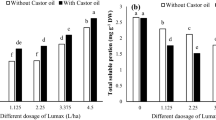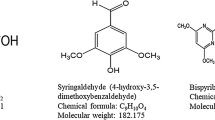Abstract
Effects of three allelochemicals (2-benzoxazolinone (BOA), p-hydroxybenzoic, and ferulic acid) and two herbicides (linuron and fluometuron) on chlorophyll fluorescence, photosynthesis, accumulation of free proline and polyamines, and total content of soluble proteins were measured to assess herbicidal activity on Dactylis glomerata. The application of chemicals generally reduced Fv/Fm (more than 25 % with p-hydroxybenzoic acid, BOA, or linuron). BOA decreased the quantum efficiency of PSII temporarily, but it did not affect photosynthesis. Polyamine content was very low, while proline content was markedly affected by some of the chemicals, thus producing some osmotic adjustment. Ferulic acid did not cause any physiological effect at all. BOA and p-hydroxybenzoic acid caused significant changes in various physiological traits of Dactylis glomerata, specially interfering with the quantum efficiency of the PSII.
Similar content being viewed by others
Abbreviations
- A:
-
net photosynthesis rate
- BOA:
-
2-Benzoxazolinone
- FMS:
-
fluorescence monitoring system
- Fo:
-
minimal fluorescence in the dark adapted state-yield of intrinsic fluorescence
- Fv:
-
yield of variable fluorescence in dark adapted state
- Fv:
-
Fm-Fo
- Fm:
-
maximal fluorescence in the dark adapted state
- Fv/Fm:
-
photochemical trapping efficiency of the dark adapted state
- Fm’:
-
maximal fluorescence in the light adapted state
- ΔF:
-
(Fm’-Fs’)
- Fs:
-
steady state fluorescence yield
- ΔF/Fm’:
-
Photosystem II photochemical efficiency in the light-adapted state
- PSI:
-
photosystem I
- PSII:
-
photosystem II
References
Arnon D. I., Hoagland D.R. 1940. Crop production in artificial solutions and in soils with special reference to factors influence yields and absorption of inorganic nutrients. Soil Sci. 50: 463–485.
Babani F., Lichtenthaler H.K. 1996. Light-induced and age-dependent development of chloroplast in etiolated barley leaves as visualized by determination of photosynthetic pigments, CO2 assimilation rates and different kinds of chlorophyll fluorescence ratios. J. Plant Physiol. 148: 555–566.
Blum U., Shafer S.R. 1988. Microbial populations and phenolic acid in soil. Soil Biol. Biochem. 20: 793–800.
Cameron H.J., Julian G.R. 1980. Inhibition of protein synthesis in lettuce (Lactuca sativa L.) by allelopathic compounds. J. Chem. Ecol. 6: 989–995.
Chase W.C., Nair M.G., Putman R. 1991. 2,2-oxo-1,1-azobenzene: selective toxicity of rye allelochemicals to weed and crop species II. J. Chem. Ecol. 17: 9–19.
Cobb A. 1992. Herbicides that inhibit photosynthesis. In: Herbicides and Plant Physiology. Chapman and Hall, London.
Corcuera L.J., Woodward M.D., Helgeson J.P., Kelman A., Upper C.D. 1978. 2,4-dihydroxy-7-methoxy-2h-1,4-benzoxazin-3(4h)-one, an inhibitor from Zea mays with differential activity against soft rotting erwinia species. Plant Physiol. 61: 791–795.
Cuevas L., Niemayer H.M., Johnsson L.M.V. 1992. Partial purification and characterization of a hydroxamic acid glucoside (D-glucosidase from maize). Phytochem. 31: 2609–2612.
Devi S.R., Prasad M.N.V. 1996. Influence of ferulic acid on photosynthesis of maize: analysis of CO2 assimilation, electron transport activities, fluorescence emission and photophosphorylation. Photosynthetica 32: 117–127.
Einhelling F.A. 1993. Allelopathy: Current Status and Future Goals. In Allelopathy, Organisms, Processes, and Applications, pp. 1–23; Inderjit; Dakshini KMM and F.A. Einhellig (eds.); ACS Symposium Series, Ames, Iowa.
Friebe A., Wieland I., Schulz M. 1996. Tolerance of Avena sativa to the allelochemical benzoxazolinone. degradation of BOA by root-colonizing bacteria. J. Appl. Bot. 70: 150–154.
Galston A.W., Kaur-Sawhney R. 1990. Polyamines in plant physiology. Plant Physiol. 94: 406–410.
González L., Souto X.C., Reigosa M.J. 1997. Weed control by Capsicum annuum. Allelopathy J. 4: 101–110.
González-Moro B., Lacuesta M., Iriberri N., Muňoz-Rueda A., Gonzalez-Murua C. 1997. Comparative effects of PPT and AOA on photosynthesis and fluorescence chlorophyll parameters in Zea mays. J. Plant Physiol. 151: 641–648.
Hanson A.D. 1980. Interpreting the metabolic responses of plants to water stress. Hort. Sci. 15: 623–629.
Ireland C.R., Percival M.P., Baker N.R. 1986. Modification of the induction of photosynthesis in wheat by glyphosate, an inhibitor of amino acid metabolism. J. Exp. Bot. 37: 299–308.
Krause G.H., Weis E. 1984. Chlorophyll fluorescence as a tool in Plant Physiology. II. interpretation of fluorescence signals. Photosynth. Res. 5: 139–157.
Macías F.A. 1993. Allelopathy in Search for Natural Herbicide Models. In Allelopathy, Organisms, Processes, and Applications, pp. 310–329; Inderjit, Dakshini KMM and FA Einhellig (eds.); ACS Symposium Series, Ames, Iowa.
Manchikatla V.R. 1997. Polyamines. In Plant Ecophysiology, pp. 343–374; Prasad MNV (ed.); John Wiley & Sons; Inc; New York.
Maxwell K., Johnson, G.N. 2000. Chlorophyll fluorescence — a practical guide. J. Exp. Bot. 51: 659–668.
Mersie W., Singh M. 1993. Phenolic acids affect photosynthesis and protein synthesis by isolated leaf cells of velvet-leaf. J. Chem. Ecol. 19: 1293–1130.
Niemayer H.M. 1988. Hydroxamic acids (4-hydroxy-1,4-benzoxazin-3-ones), defence chemicals in the gramineae. Phytochem. 27: 3349–3358.
Paleg L.G., Stewart G.R., Bradbeer J.W. 1984. Proline and glycine-betaine influence protein solvation. Plant Physiol. 75: 974–978.
Pedrol N., Ramos, P., Reigosa, M.J. 2000. Phenotypic plasticity and acclimation to water deficits in velvet-grass: a long-term greenhouse experiment. Changes in leaf morphology, photosynthesis and stress-induced metabolites. J. Plant Physiol. 157: 383–393.
Pedrol N., Tiburcio, A.F. 2001. Polyamines determination by TLC and HPLC. In: Handbook of Plant Ecophysiology Techniques, 335–363. Ed. M.J. Reigosa. Kluwer Academic Publishers, Dordrecht, The Netherlands.
Perez F.J., Ormeňo-Nuňez J. 1991. Difference in hydroxamic acid content in roots and root exudates of wheat and rye: possible role in allelopathy. J. Chem. Ecol. 17: 1037–1043.
Powell R.G., Spencer G.F. 1987. Phytochemical inhibitors of velvet leaf (Abutilon theophrasti). Germination as models for new biorational herbicides. In: Biologically Active Natural Products. Potential Use in Agriculture, pp. 211–232; Cutler HG (ed.).
Ramos P., Pedrol N. 2001. Free proline quantification. In: Handbook of Plant Ecophysiology Techniques, 365–382. Ed. M.J. Reigosa. Kluwer Academic Publishers, Dordrecht, The Netherlands.
Reigosa M.J., Weiss O. 2001. Fluorescence techniques. In: Handbook of Plant Ecophysiology Techniques, 155–171. Ed. M.J. Reigosa. Kluwer Academic Publishers, Dordrecht, The Netherlands.
Reigosa M.J., Sánchez-Moreiras A.M., González L. 1999a. Ecophysiological Approach in Allelopathy. Critical Reviews in Plant Sci. 18: 577–608.
Reigosa M.J., González L., Souto X.C. 1999b. Effect of phenolic compounds on the germination of six weed species. Plant Growth Regul. 28: 83–88.
Rice E.L. 1984. Allelopathy, 2nd ed. pp. 422. Academic Press, New York.
Romera E., Dominguez C., Calero M.D., De Prado R. 1992. Efecto del fluometuron sobre dos variedades de algodón: Coker-310 y Crema. Actas Congreso Sociedad EspaZola de Malherbologia 307–310.
Singh K.P., Singh K. 1993. Influence of stimulated water stress on free proline accumulation in Triticum aestivum L. (wheat). Indian J. Plant Physiol. 26: 319–321.
Weiss, O., Reigosa M.J. 2001. Modulated fluoresence. In: Handbook of Plant Ecophysiology Techniques, 173–183. Ed. M.J. Reigosa. Kluwer Academic Publishers, Dordrecht, The Netherlands.
Weston L.A. 1996. Utilization of allelopathy for weed management in agroecosystems. Agron. J. 88: 860–866.
Yamane A., Nishimura H., Mizutani J. 1992. Allelopathy of yellow fieldcrest (Rorippa sylvestris): identification and characterization of phytotoxic constituents. J. Chem. Ecol. 18: 683–691.
Yoshiba Y., Kiyosue T., Nakashima K., Yamaguchi-Shinozaki K., Shinozaki K. 1997. Regulation of levels of proline as an osmolyte in plants under water stress. Plant Cell Physiol. 38: 1095–1102.
Yu J.Q., Matsui Y. 1994. Phytotoxic substances in root exudates of cucumber (Cucumis sativus L.). J. Chem. Ecol 20: 21–31.
Zhu H., Malli A.U. 1994. Interactions between kalmia and black spruce: isolation and identification of allelopathic compounds. J. Chem. Ecol. 20: 407–421.
Author information
Authors and Affiliations
Corresponding author
Rights and permissions
About this article
Cite this article
Durán-Serantes, B., González, L. & Reigosa, M.J. Comparative physiological effects of three allelochemicals and two herbicides on Dactylis glomerata . Acta Physiol Plant 24, 385–392 (2002). https://doi.org/10.1007/s11738-002-0034-4
Received:
Accepted:
Issue Date:
DOI: https://doi.org/10.1007/s11738-002-0034-4




